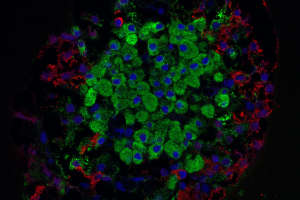Scientists have used gene therapy to make insulin-producing cells in a mouse's pancreas
 Insulin producing cells (like the ones shown in green) have
Insulin producing cells (like the ones shown in green) have
been made in a mouse's pancreas. Photo credit by Masur.
A new study out in Nature shows how to turn one kind of pancreas cell into an insulin-producing islet cell. This research is an important step in finding a cure for Type 1 diabetes.
People get Type 1 diabetes when their bodies attack and destroy their own islet cells. These people can't make insulin anymore and so have to inject it. The best cure would be if scientists could replace the old islet cells with new ones. This is what the researchers in this study set out to do in mice.
The researchers made islet cells directly in a mouse’s pancreas. They did this by using gene therapy to reprogram one type of pancreas cell (an exocrine cell) into islet cells.
All cells share the same DNA. What makes each cell type different is which genes are on (or have been on in the past). Proteins called transcription factors are a big part of this programming.
The authors reasoned that they might be able to directly reprogram one kind of adult cell into another by adding the right mix of transcription factors. They couldn't just add transcription factors though. Instead, they added transcription factor genes*.
